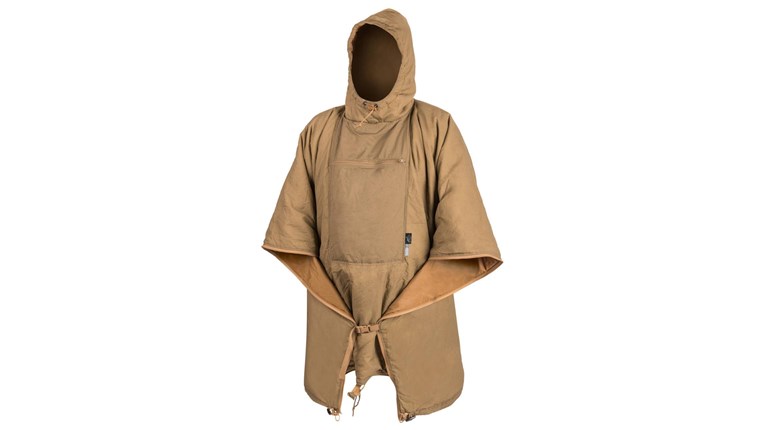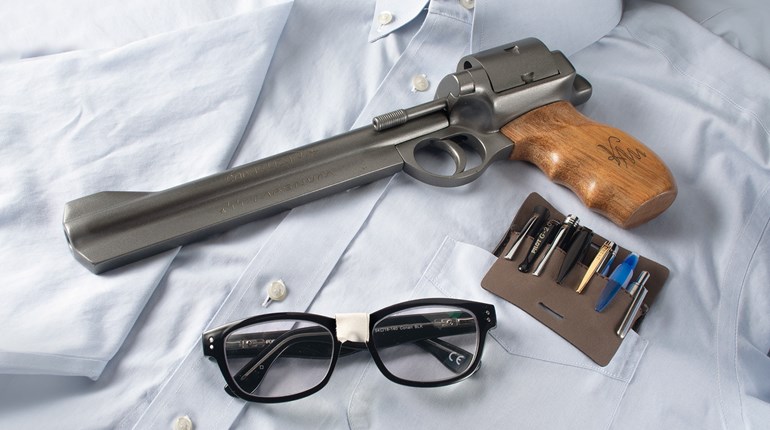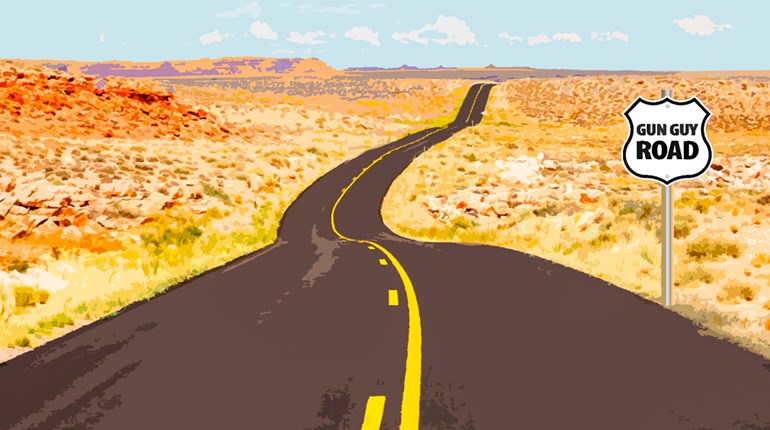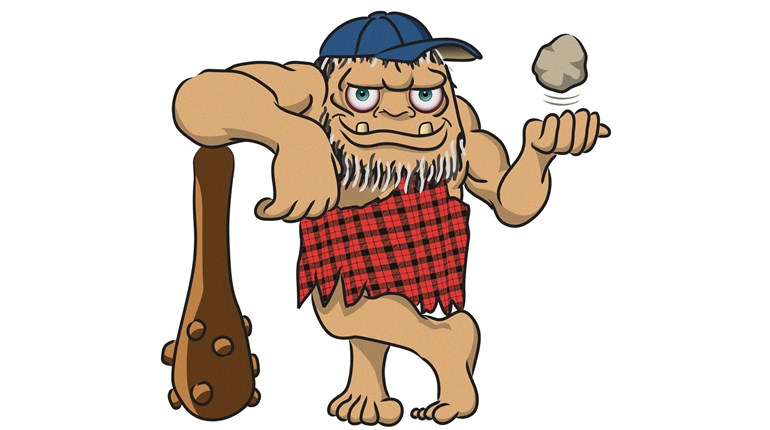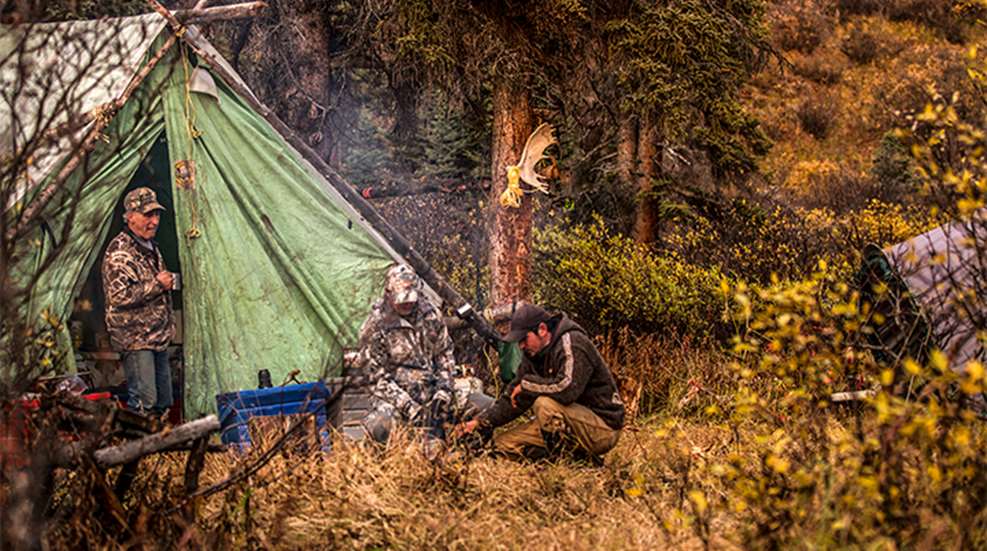
Hunting has changed over the generations, of that there is little doubt. One of the fading hunting arts is that of the tent camp.
I am not talking so much about a backcountry hunt where you pack in on horses, or even on your own hind feet. Those kinds of tent camps are a big part of hunting and should be on every bucket list, but what I am talking about here is the traditional tent camp. It was for generations a big part of hunting, but it’s slowly fading away. That’s a shame, as a tent camp hunt can be one of the best outdoor experiences you will ever have, and in the never humble opinion of this hunter, experiences are the trophies most worth collecting.
From a modern perspective, tent camps can provide mobility, which adds to success. A tent camp lets you move to follow the game and to access remote locations. It also is a lot less expensive than a camper or RV.
I am speaking of a camp you can drive to and that is comfortable and equipped well enough for a long weekend or an entire hunting season. Two men can set up mine, complete with a covered cooking area, outhouse and shower, in less than half a day, and it all fits in the bed of my pickup truck.
Here are a few tips on what I have learned after decades setting up and hunting from tent camps.
The Tent
Any tent can work if it keeps the rain off and the bugs out, but some tents are simply more equal than others. I have spent more than my share of nights in a small pup tent. The little tent was fun when I was a kid and necessary on backcountry hunts. It’s fine for a quick weekend hunt, but it gets crowded and uncomfortable pretty fast. Also, for those of us with the creaking bones of experience, a pup tent can be difficult to get in and out of. I mostly use mine now for a dry place to store gear at camp—or as a place to stick the guy who snores the loudest.
The tent is your home, so choose wisely. After two weeks in a tent, including a day or two of being weathered in, I have never known a hunter to say, “Gee, I wish this tent was smaller.”
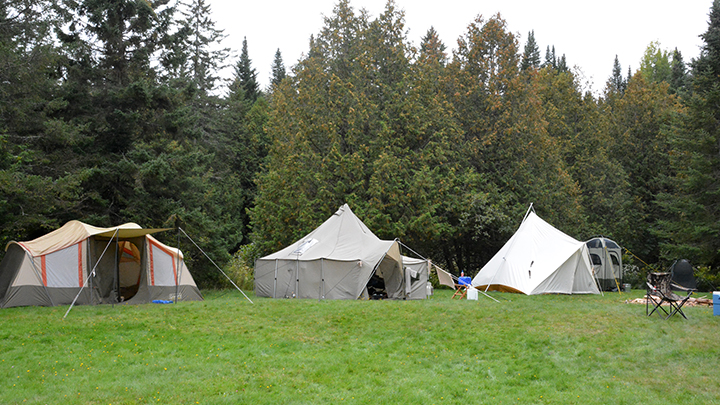
You can get by with an inexpensive tent, particularly if you are not camping in winter weather. But as this tent camping bug digs deep into your soul you will want a true four-season tent. That usually means an outfitter-style tent. In most places you will need heat, so choose a tent that is rated for a heat source, as those that are not vented properly can be dangerous.
Most outfitter-style tents are designed to use a wood stove. Again, choose well. My stove is too small and unless somebody refills it every couple of hours the tent is very cold by morning. Life is tough, but never tougher than the moment when you have to leave a warm sleeping bag to restart the fire.
While I would love to own a large traditional Rocky Mountain-style wall tent, it has always eluded my budget. When I was planning to work on my book Benoit Bucks, I knew we would be camping in Canada for the better part of a month. I ordered a Cabela’s 12-by-12-foot Deluxe Alaknak II tent for about half the price of a custom-made wall tent. I can set it up alone in about an hour and it’s big enough for one hunter, or two if they like each other. Somehow, two decades later, I just never got around to buying the wall tent.
Cabela’s still sells this model, but I can’t attest to the quality of it now. I hope it’s still as well made as mine, which has seen a lot of use. My son and I once weathered a bad nor’easter that whipped it like a hurricane. The wind blew so hard I wasn’t sure I would still have a truck parked outside when it was over. I am amazed that all the tent seams held.
I have set it up as the “kids' tent” during family reunions and turned loose a herd of preadolescent monsters to live in it for a week at a time—which is probably even tougher on the tent. It’s been a great tent and I have more than gotten my money’s worth, but it’s showing its age.
Maybe it’s time to shop for that wall tent, after all.
If I do, I’ll follow my own advice to “buy a bigger tent than you think you need, and make sure you have a good way to keep it warm.” You want room for all your gear and a camp chair. If you get weathered in for a while the cot gets pretty tedious. A chair to sit down in is civilized. It’s also a blessing when you are putting on your socks and boots.
Sleeping
There is no question that if you sleep well you will hunt well. I have spent enough nights lying on cold, rocky ground, encased in a damp sleeping bag, to know that it’s not the best way to be sharp in the morning. I love sleeping in a tent; it’s the best sleep I get. But, part of that is because I pay attention to comfort.
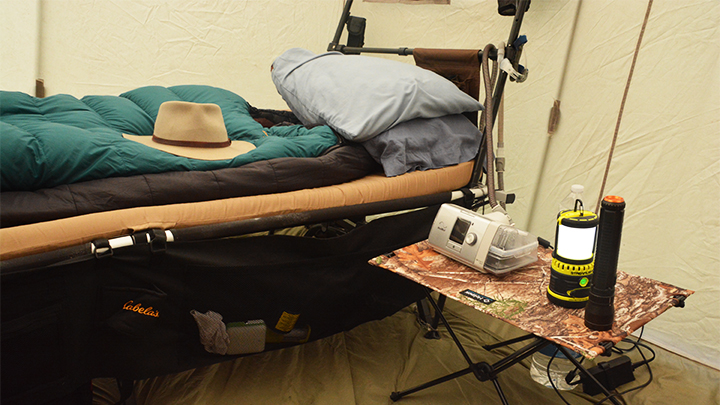
Get a good cot, one that’s big enough. Most are too narrow. I hate sleeping on a cot so small that when I lie on my back there is no place for my arms other than to hang over the sides. I don’t know the model, but it’s the one every hunting outfitter on earth buys for their camps.
I have a “big man” cot that is 40 inches wide and designed for a lot of weight. I had a wonderful 3-inch-thick foam pad, but I loaned it to a relative with a Lab puppy and now I don’t. I have never found another like it, but I do have the thickest pad I could buy.
Bring a pillow; don’t just roll up your wet jacket under your head. Make sure you have a sleeping bag that is both big enough and warm enough. Two things I hate are the claustrophobic feeling of a cheap imported mummy bag and shivering all night long.
Bathroom Duties
I arrived in the remote Alaska bear camp dehydrated from the long day of travel. I filtered some water out of the river and downed a bottle. Later I felt the need for the bathroom. “Oh we just go upriver to that little sandbar and find a tree,” the outfitter told me.
Besides the obvious sanitary issues, wandering in the dark looking for a tree became a game of “dodge a landmine” by the end of the week. Sadly, even though it was filthy and disgusting, that was not even close to the worse aspect of that hunting trip.
There is no reason to be uncomfortable. There are a lot of portable toilets and pop-up outhouses on the market. Mine is the Cleanwaste “Go Anywhere Total System,” available just about any place that sells camping gear. It’s a little expensive, but it has served a lot of camps for a lot of years. That includes a youth deer camp I helped to run for many years. Quality lasts.
The tent sets up quickly. The seat is designed to be used with disposable bags that have chemicals inside to deal with the waste. They work fine in places it’s required (or inside the heated main tent on a bitter cold day) but they can get expensive. I prefer to dig a small round hole deep into the ground. When breaking camp, I just fill it in. The outhouse tent heats up quickly with a gas lantern or, in cold weather, a portable heater. Take the latest copy of American Hunter to read and you will have all the comforts of home.
My only complaint with the Cleanwaste seat is it is pretty low to the ground. An older hunter with bad knees might struggle using it (I know a guy like that). So I simply attach a rope high up in a tree in front and run it to the outhouse. The participant can then hold the rope and use his arms to lower or lift into position. It’s a small thing, but it can make a big difference for a less agile user.
Light it Up
There is nothing on earth that can compare to watching a dying campfire and listening to the hiss of a pressurized gas lantern. It’s the sound of freedom. They will pry my gas lantern from my cold, dead hands. I always bring several gas and propane lanterns on any hunt and they see a lot of use.
However, for inside the tent and for a portable light for late-night visits to the “reading room,” the new generation of rechargeable lanterns like Streamlight’s Super Siege is a better choice. They are instant on, instant off and provide a bright light, equal to a propane lantern. No heated globe to burn your fingers or the need to find matches in the dark. They can even charge your phone.
It’s a rechargeable world anyway. I have seen grown men in a panic because their phone needed charging and there was no way to do that in camp. These are odd times we live in.
I use a BiPAP machine to sleep with so I take to camp a large deep-cycle battery, which needs charging. You can charge all this stuff off your truck, but it’s better to bring a generator to recharge everything.
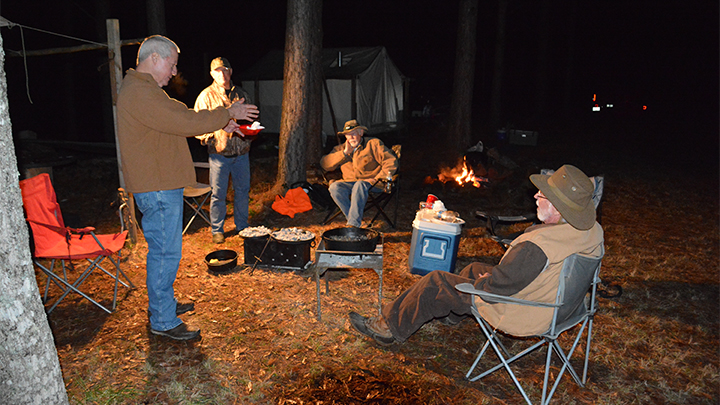
That doesn’t have to be expensive. I have a two-stroke generator I bought from Harbor Freight a few years back for less than a hundred bucks. I also have a Honda 2,000-watt generator I got when I was doing the Benoit book. I place it away from camp and it’s so quiet you almost can’t hear it run. I’ll confess, when we ran the youth camp, I had a microwave and a toaster that we ran off the Honda, although the toaster did make it squat and grunt when it started.
I don’t know the lifespan of the two-stroke as it’s mostly for backup, but I can tell you this Honda has seen a lot of use in 20 years and it’s never faltered. I even changed the oil once … I think.
Keep it Clean
What’s the worst smell on earth? Some say it’s the corpse flower that blooms once a decade. Clearly such people have never smelled a hunter after 10 days without a shower!
There is no reason to stink. There are a lot of pop-up shower tents on the market and I recommend one in every tent camp. Just place it where the drainage will not cause any problems and use environmentally friendly soap you can find in any backcountry supply store. I take a small wooden pallet to stand on to keep my feet off the muddy ground. A portable propane heater makes it comfortable. The solar-heated shower bags are fine and you can fill them with preheated water in cold weather. But I prefer to use a 3-gallon metal pail I got at a farm supply store. I heat the water over the camp stove and use a red Solo cup to dip and pour over myself.
I always have a hand washing station set up central to the camping area. I use a 5-gallon water jug with a spout like a faucet. Keep some soap close by, and a towel. Better yet, a roll of paper towels is more sanitary than a single cloth towel. Put an empty plastic 5-gallon bucket underneath the spout to catch the water. This keeps the area from becoming a muddy mess and it lets you dispose of the dirty water in a safe place.
Cooking
Hunters, like armies, march on their stomachs. Besides, a huge portion of the tent camp social experience occurs in the kitchen. So, in my never humble opinion, the best tent camps have the best cooking areas. It can be as simple as a small stove in the open air, but I prefer a larger, covered area.
I like camp cooking and volunteer to cook whenever I can. My rule is simple: I cook, but I don’t do dishes. We use paper plates and cups and disposable cutlery anyway. It all goes in the garbage or the campfire. So the guy doing dishes has a pretty easy job.
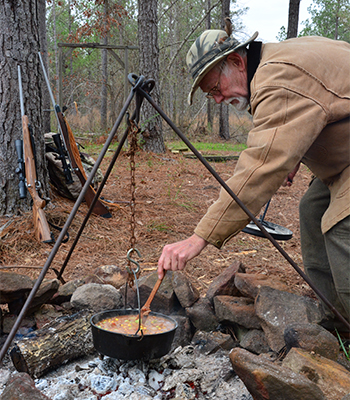
Some of the best camps I have been in have multiple guys who pride themselves on camp cooking. Taking turns becomes a competition and the food can be outstanding. In our Vermont bear camp last year, Neal Brown cooked a fried venison lunch with Dutch oven cornbread and peach cobbler that was way beyond good.
If your camp has an old guy who just likes hanging around camp and cooking, you hit the jackpot. Treasure that guy, because he won’t be around nearly long enough.
No matter if you are just heating up some leftover stew after a brutal day of tracking a big buck or making a five-course camp dinner for all your buddies, the kitchen is where the magic happens. Set up a separate cooking area and put a roof over it to protect your tools and food.
When we ran the youth camp I used one of those big portable 10-by-28-foot garages with a white cover and metal frame. We heated it with a 55-gallon barrel stove I made from a kit. But something that big is a lot of work to set up. In the last tent camp we used an expandable 12-by-12-foot canopy I repurposed after my daughter’s wedding. An engineering marvel, the support structure expands when you pull on the corners and the thing sets up in minutes. We simply tied on some cheap tarps as sides to keep out the wind and rain. Three folding tables and several chairs finished out the area.
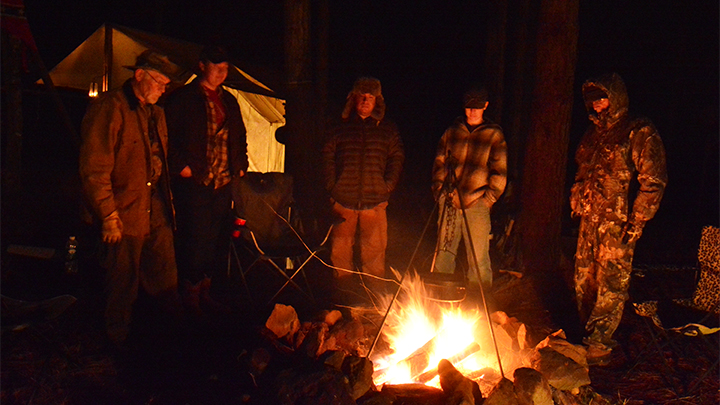
I have a couple of more tips. Get a griddle. I have one for my Camp Chef three-burner stove that covers two of the burners and it is where we did most of our cooking during that weeklong bear camp last fall. Always cook a little over the campfire. It just doesn’t feel like a camping trip until you do. And be sure to cook with a Dutch oven to bring soul and tradition to a tent camp—another tip the graybeards should appreciate. Too many stupid activities when I was young have coerced my back into open rebellion in recent years, so cooking with the Dutch oven sitting on the ground is just not much fun anymore. Late one night, during an insomniac haze, I was surfing the Web and helped Jeff Bezos get a little richer when I bought a Camp Chef metal table. It’s designed to be used with Dutch ovens and allows standing up while you cook. I am not saying that all my late-night purchases have been smart, but this one sure was.
It doesn’t matter if you look at a portable camp as a way to access new hunting grounds or if you just like camping, take a hint from an old guy who has been doing it for a while and make it comfortable. Comfortable keeps it fun, and if it’s not fun, why bother?
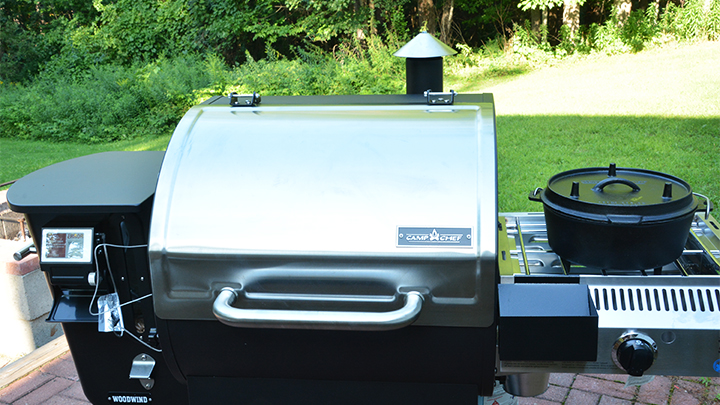
Camp Chef Woodwind Pellet Grill
OK, so it’s time to ‘fess up. My camp “used” to fit in my pickup. But, now I have a 6-by-10-foot trailer I haul around too. Why? I like my comforts and I like to eat. So my camp keeps growing. The latest addition is another one of those “why did I wait so long to get this thing?” items.
It seems like the latest craze in outdoor cooking has spawned a competition in pellet grills/smokers. They just keep getting better and better. Take the Camp Chef Woodwind 24 model with the Sidekick option, for example. This thing will grill a steak or smoke a brisket. The Sidekick option includes a burner that will make coffee or cook the side dishes. It also has a grill for cooking eggs, bacon and just about everything else. I added the Grill Box, so I have a small gas grill for a quick meal. Switching from one to the other takes seconds.
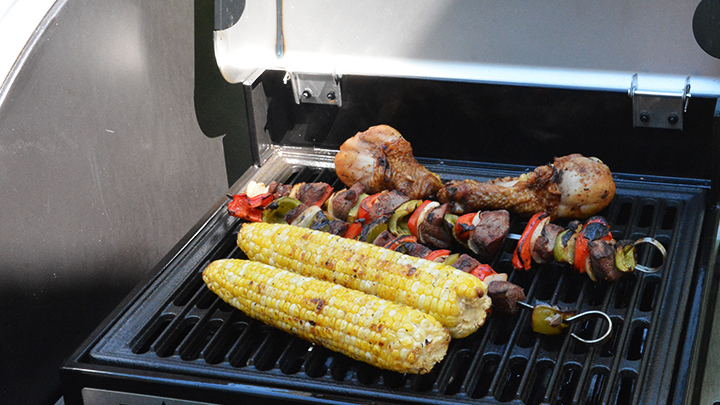
I have a theory (still unproven) that smokers make food taste so good that you could smoke moose droppings and the result would be delicious.
With the “low and slow” smoker you can load a big haunch of venison (or meat of your choice) before you leave to go hunting. The Woodwind will smoke it while you are waiting for a buck or chasing your bird dogs. When you roll into camp that night, tired and hungry, dinner is waiting—done to perfection. It does need a power source; a generator or a deep-cycle battery with an inverter will work fine.
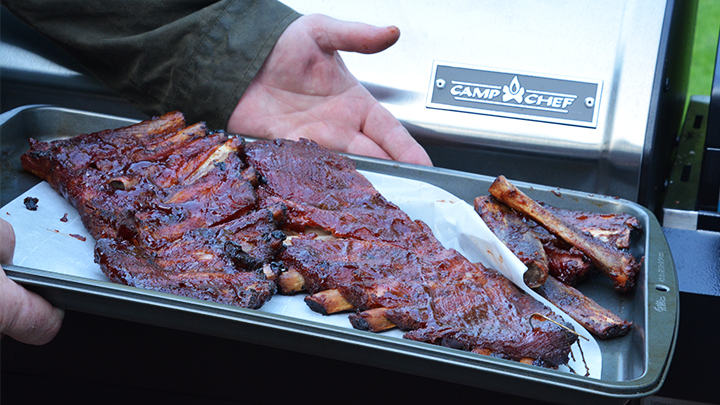
Its offseason home is my brick patio, where it will see a lot of use all year-round. That is how you justify buying one for your hunting camp—that and the fact this thing will make anybody a master camp cook. For more information, visit campchef.com.












